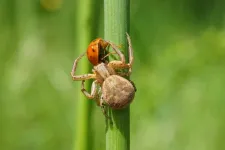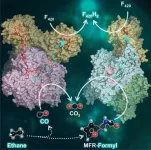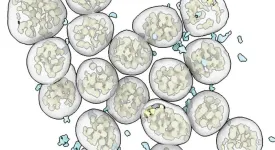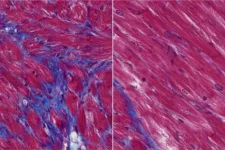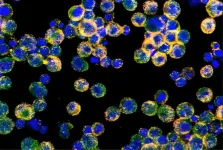(Press-News.org) Animals not only need sufficient calories to function, but also essential nutrients — including omega-3 and omega-6 polyunsaturated fatty acids (PUFA). Insects and arachnids are an important source of these essential fatty acids for birds, hedgehogs, lizards and the like. However, the content depends on the specific types of insects and spiders consumed. Aquatic insects, such as caddisflies or dragonflies, contain significantly more omega-3 long-chain (LC) PUFA than terrestrial insects because omega-3- LC-PUFA rich algae form the base of the food chain in aquatic ecosystems.
The content of fatty acids can also accumulate throughout food chains: a mayfly often contains more than the algae it feeds on, but less than the fish that preys on mayflies. There are existing studies on this, as well as many studies on how plant or algal biodiversity affects biomass availability in ecosystems. “However, little is known about the effect of insect and arachnid biodiversity on the availability of fatty acids in an ecosystem’s food web,” says Cornelia Twining, group leader “Food Web Ecophysiology” at the aquatic research institute Eawag and professor at ETH Zurich. She and her colleagues aimed to close this knowledge gap.
Over 700 land and water ecosystems examined
The researchers used a data set with over half a million observations of around 7600 insect and spider species in Switzerland. The approximately 400 aquatic ecosystems and 300 terrestrial ecosystems in the study vary in land use — some in natural habitats such as extensive meadows or forests, others in agricultural areas or in the middle of a city. For each of these ecosystems, the researchers calculated the biomass and biodiversity of insects and arachnids and the amounts of different key PUFAs they provide in total. “We were interested in how land use shapes energy and nutrient availability and whether there are key differences between aquatic and terrestrial ecosystems,” says Ryan Shipley, researcher at the WSL institute for snow and avalanche research SLF and the lead author on the study. “Land use change ranks among the most urgent global challenges, making it essential to understand how human activities impact fundamental ecosystem functions," explains Shipley.
Fatty acid content in the food web declines with decreasing biodiversity
Data analysis revealed that in all the studied communities, a decrease in insect and spider biodiversity was accompanied by a decline in biomass and the content of key fatty acids. "In terrestrial communities, we also see significant differences depending on land use," says Twining. Even when biodiversity is the same, insect and spider communities in a city park typically provide fewer omega-3 LC-PUFA than those in a forested area. "This is partly due to the different species composition of these populations, and partly because the biomass is smaller in urban areas: there are also fewer predators like spiders or large beetles, which accumulate LC-PUFA in terrestrial systems," Twining explains.
"What surprised us was that in aquatic communities, the effect of land use is much less pronounced. For a given number of species, streams in urban areas have a similarly fatty acid content to streams in forests." The researchers explain this by noting that aquatic insects generally contain higher amounts of Omega-3 LC-PUFA compared to terrestrial taxa. On land, the differences are more significant: when predators like spiders, which accumulate high amounts of essential fatty acids, disappear from the ecosystem, the impact is considerable. “However, this does not mean that the biodiversity of aquatic insects is any less important,” says Twining.
Aquatic ecosystems are a crucial fatty acid source, especially in urban areas
On the contrary: aquatic ecosystems can be key sources of fatty acids for terrestrial food webs. In urban areas, where the loss of insects and spiders is particularly high due to increasing human land use pressure, aquatic insects become an even more important source of essential fatty acids for birds, bats, or lizards. This “superfood” is unfortunately increasingly accompanied by pollutants in streams, rivers, and lakes, though. “Our study shows how important it is to protect biodiversity, especially in agricultural and urban areas, and to improve water quality in order to preserve food webs for ecosystem functioning”, Twining emphasizes.
Blue-Green Biodiversity Research Initiative
The research project «Predator coupling of aquatic and terrestrial ecosystems: the importance of nutritional diversity of prey» contributes to the Blue-Green Biodiversity Research Initiative – an Eawag-WSL collaboration that focuses on biodiversity at the interface of aquatic and terrestrial ecosystems. The initiative is funded by the ETH Board.
END
Biodiversity increases nutrient availability
Biodiversity increases organic nutrient availability across ecosystems
2024-10-23
ELSE PRESS RELEASES FROM THIS DATE:
American Society of Anesthesiologists names Donald E. Arnold, M.D., FACHE, FASA, new president
2024-10-23
PHILADELPHIA — Donald E. Arnold, M.D., FACHE, FASA, chair of the Department of Anesthesiology, Mercy Hospital in St. Louis and member of the board of directors of Western Anesthesiology Associates, Inc., in Ballwin, Missouri, was today named president of the American Society of Anesthesiologists (ASA), the nation’s largest organization of anesthesiologists. Dr. Arnold assumed office at the ANESTHESIOLOGY® 2024 annual meeting and will serve for one year.
“I’m honored to be named president of ASA and committed to serving our members, supporting the Society’s mission to advance the specialty, preserving physician-led anesthesia care, and above ...
Family as a wealth factor
2024-10-23
Wealth is one of the strongest indicators of social status, acting as a key indicator of social inequality and influencing access to education, health care and professional success. In a study, researchers from the Max Planck Institute for Demographic Research, the University of Cologne, GESIS and the Norwegian Institute of Public Health examined how financial wealth changes related to various generational transitions within families. The study used data from Norwegian registries and focused on people born in 1953.
Investigating changes in wealth within the ...
Breathing deep: A metabolic secret of ethane-consuming archaea unraveled
2024-10-23
Seeps on the deep seafloor naturally emit alkanes, which are pollutants that are potentially dangerous to life and act on global warming. Fortunately, the sediments around the seeps host microbes that act as a biological filter: They consume most of the alkanes before their release into the oceans and our atmosphere. This so-called anaerobic oxidation of alkanes is an important yet poorly understood microbial process. Scientists from the Max Planck Institute for Marine Microbiology in Bremen, Germany, now ...
NIH clinical trial will test precision medicine treatments for myeloid cancers
2024-10-23
The National Institutes of Health (NIH) has launched a proof-of-concept precision medicine clinical trial to test new treatment combinations targeting specific genetic changes in the cancer cells of people with acute myeloid leukemia (AML) and myelodysplastic syndromes (MDS). The trial, funded by NIH’s National Cancer Institute (NCI), aims to accelerate the discovery of more tailored treatments for these aggressive cancers of the blood and bone marrow.
“AML and MDS are a heterogeneous group of cancers that can progress very quickly. Treatment advances depend in part on the ability to rapidly identify which subtype of cancer each patient has so that treatments can be tested for ...
Novel antibody platform tackles viral mutations
2024-10-23
New York, NY, October 23, 2024 — Scientists at the Icahn School of Medicine at Mount Sinai, in collaboration with colleagues in the field, have developed an innovative antibody platform aimed at tackling one of the greatest challenges in treating rapidly evolving viruses like SARS-CoV-2: their ability to mutate and evade existing vaccines and therapies.
Their findings, including preclinical studies in mice, introduce the Adaptive Multi-Epitope Targeting and Avidity-Enhanced (AMETA) Nanobody Platform, a new antibody approach for addressing how viruses like SARS-CoV-2, which causes COVID-19, evolve to evade vaccines and treatments. Details on the results were published October 23 ...
myeloMATCH precision medicine trials in myeloid leukemias open to patient enrollment across US and Canada
2024-10-23
Four leading cancer research organizations in the United States and Canada announce the opening of patient enrollment to myeloMATCH, a unique portfolio of clinical trials to test precision medicine treatments for adults with acute myeloid leukemia (AML) or myelodysplastic syndrome (MDS).
The Alliance for Clinical Trials in Oncology, Canadian Cancer Trials Group, ECOG-ACRIN Cancer Research Group, and SWOG Cancer Research Network are collaborating within the National Cancer Institute (NCI) National Clinical Trials Network (NCTN) to design and lead the trials. They expect to open ...
Social determinants of health and US health care expenditures by insurer
2024-10-23
About The Study: In this cross-sectional study of 14,000 insured adults, individual-level social determinants of health were significantly associated with U.S. health care expenditures by Medicare, Medicaid, and private insurers. These findings may inform health insurers and policymakers to incorporate social determinants of health in their decision-making practices to identify and control health care expenditures, advancing health equity.
Corresponding Author: To contact the corresponding author, Giridhar Mohan, MPH, email gmohan1@jhu.edu.
To access the embargoed study: Visit our For The Media website at this link https://media.jamanetwork.com/
(doi:10.1001/jamanetworkopen.2024.40467)
Editor’s ...
Traumatic and adverse childhood experiences and developmental differences in psychiatric risk
2024-10-23
About The Study: In this cohort study, distinct forms of traumatic and adverse childhood experiences differentially moderated developmental changes in psychiatric risk and cognitive ability in different ways, offering the possibility for precision-based prediction of risk for youth. Such findings could be used in targeted early prevention and intervention strategies for at-risk youth.
Corresponding Author: To contact the corresponding author, Justin D. Russell, PhD, email jdrussell3@wisc.edu
To access the embargoed study: Visit our For The Media website at this link https://media.jamanetwork.com/
(10.1001/jamapsychiatry.2024.3231)
Editor’s ...
Immunotherapy blocks scarring, improves heart function in mice with heart failure
2024-10-23
A new study from Washington University School of Medicine in St. Louis suggests that a type of immunotherapy — similar to that approved by the Food and Drug Administration (FDA) to treat inflammatory conditions such as arthritis — also may be an effective treatment strategy for heart failure.
The study is published Oct. 23 in the journal Nature.
After a heart attack, viral infection or other injury to the heart, scar tissue often forms in the heart muscle, where it interferes with the heart’s normal contractions and plays a leading role in heart failure, the progressive loss of the heart’s ...
Discovery finds how ovarian cancer disables immune cells
2024-10-23
Weill Cornell Medicine researchers have discovered a mechanism that ovarian tumors use to cripple immune cells and impede their attack—blocking the energy supply T cells depend on. The work, published Oct. 23 in Nature, points toward a promising new immunotherapy approach for ovarian cancer, which is notoriously aggressive and hard to treat.
A significant obstacle in treating ovarian cancer is the tumor microenvironment—the complex ecosystem of cells, molecules and blood vessels that shields cancer cells from the immune system. Within this hostile environment, T cells lose their ability to take up the lipid (fat) molecules, which are necessary for energy to mount ...
LAST 30 PRESS RELEASES:
Boosting the cell’s own cleanup
Movement matters: Light activity led to better survival in diabetes, heart, kidney disease
Method developed to identify best treatment combinations for glioblastoma based on unique cellular targets
Self-guided behavioral app helps children with epilepsy sleep earlier
Higher consumption of food preservatives is associated with an increased risk of type 2 diabetes
NTU Singapore-led team captures first-ever ‘twitch’ of the eye’s night-vision cells as they detect light, paving the way for earlier detection of blindness-causing diseases
Global aviation emissions could be halved through maximising efficiency gains, new study shows
Fewer layovers, better-connected airports, more firm growth
Exposure to natural light improves metabolic health
As we age, immune cells protect the spinal cord
New expert guidance urges caution before surgery for patients with treatment-resistant constipation
Solar hydrogen can now be produced efficiently without the scarce metal platinum
Sleeping in on weekends may help boost teens’ mental health
Study: Teens use cellphones for an hour a day at school
After more than two years of war, Palestinian children are hungry, denied education and “like the living dead”
The untold story of life with Prader-Willi syndrome - according to the siblings who live it
How the parasite that ‘gave up sex’ found more hosts – and why its victory won’t last
When is it time to jump? The boiling frog problem of AI use in physics education
Twitter data reveals partisan divide in understanding why pollen season's getting worse
AI is quick but risky for updating old software
Revolutionizing biosecurity: new multi-omics framework to transform invasive species management
From ancient herb to modern medicine: new review unveils the multi-targeted healing potential of Borago officinalis
Building a global scientific community: Biological Diversity Journal announces dual recruitment of Editorial Board and Youth Editorial Board members
Microbes that break down antibiotics help protect ecosystems under drug pollution
Smart biochar that remembers pollutants offers a new way to clean water and recycle biomass
Rice genes matter more than domestication in shaping plant microbiomes
Ticking time bomb: Some farmers report as many as 70 tick encounters over a 6-month period
Turning garden and crop waste into plastics
Scientists discover ‘platypus galaxies’ in the early universe
Seeing thyroid cancer in a new light: when AI meets label-free imaging in the operating room
[Press-News.org] Biodiversity increases nutrient availabilityBiodiversity increases organic nutrient availability across ecosystems
